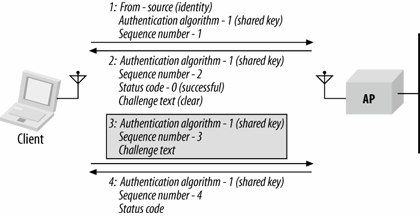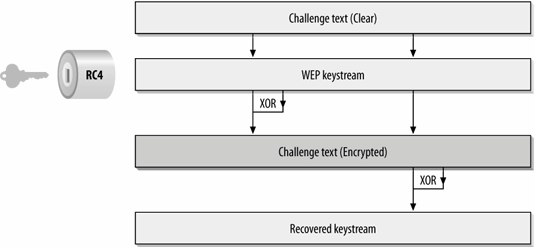Authentication
Wireless network media of any sort are open to all sorts of malicious tampering because attackers can literally immerse themselves in the network medium. Gaining a foothold is trivial if you are standing in it. Prepare now to enter the authentication twilight zone. There are multiple forms of "authentication" offered by 802.11, many of which would not pass the laugh test from serious security experts.
When most network administrators refer to authentication, the implication is that only strong authentication is worth considering as authentication. Anything that is not based on cryptography does not prove identity. With the right EAP method, 802.1X authentication can be quite strong, but 802.1X messages can only be exchanged once a system has performed a lower-level 802.11 "authentication" prior to association.
802.11 "Authentication"
802.11 requires that a station establish its identity before sending frames. This initial 802.11 "authentication" occurs every time a station attaches to a network. It should be stressed, however, that they provide no meaningful network security. There are no cryptographic secrets that are passed around or validated, and the authentication process is not mutual. It is far more accurate to think of 802.11's low-level authentication as an initial step in the handshake process that a station uses to attach to the network, and one that identifies the station to the network.
802.11 authentication is a one-way street. Stations wishing to join a network must perform 802.11 authentication to it, but networks are under no obligation to authenticate themselves to a station. The designers of 802.11 probably felt that access points were part of the network infrastructure and thus in a more privileged position.
Open-system authentication
Open-system authentication is the only method required by 802.11. Calling it authentication is stretching the meaning of the term a great deal. In open-system authentication, the access point accepts the mobile station at face value without verifying its identity. (Imagine a world where similar authentication applied to bank withdrawals!) Providing network security requires building something on top of the resulting network session. An open-system authentication exchange consists of two frames, shown in Figure 8-4.
Figure 8-4. Open-system authentication exchange

The first frame from the mobile station is a management frame of subtype authentication. 802.11 does not formally refer to this frame as an authentication request, but that is its practical purpose. In 802.11, the identity of any station is its MAC address. Like Ethernet networks, MAC addresses must be unique throughout the network and can readily double as station identifiers. Access points use the source address of frames as the identity of the sender; no fields within the frame are used to further identify the sender.
There are two information elements in the body of the authentication request. First, the Authentication Algorithm Identification is set to 0 to indicate that the open-system method is in use. Second, the Authentication Transaction Sequence number is set to 1 to indicate that the first frame is in fact the first frame in the sequence.
The access point then processes the authentication request and returns its response. Like the first frame, the response frame is a management frame of subtype authentication. Three information elements are present: the Authentication Algorithm Identification field is set to 0 to indicate open-system authentication, the Sequence Number is 2, and a Status Code indicates the outcome of the authentication request. Values for the Status Code are shown in Table 4-6.
The legacy of shared-key authentication
Shared-key authentication makes use of WEP and therefore can be used only on products that implement WEP, though non-WEP products are now nearly impossible to find. Shared-key authentication, as its name implies, requires that a shared key be distributed to stations before attempting authentication. The fundamental theoretical underpinning of shared-key authentication is that a challenge can be sent to the client, and a response proves possession of the shared key. A shared-key authentication exchange consists of four management frames of subtype authentication, shown in Figure 8-5.
The first frame is nearly identical to the first frame in the open-system authentication exchange. Like the open-system frame, it has information elements to identify the authentication algorithm and the sequence number; the Authentication Algorithm Identification is set to 1 to indicate shared-key authentication.
Figure 8-5. Shared-key authentication exchange

Instead of blindly allowing admission to the network, the second frame in a shared-key exchange serves as a challenge. Up to four information elements may be present in the second frame. Naturally, the Authentication Algorithm Identification, Sequence Number, and Status Code are present. The access point may deny an authentication request in the second frame, ending the transaction. To proceed, however, the Status Code should be set to 0 (success), as shown in Figure 8-5. When the Status Code is successful, the frame also includes a fourth information element, the Challenge Text. The Challenge Text is composed of 128 bytes generated using the WEP keystream generator with a random key and initialization vector.
The third frame is the mobile station's response to the challenge. To prove that it is allowed on the network, the mobile station constructs a management frame with three information elements: the Authentication Algorithm Identifier, a Sequence Number of 3, and the Challenge Text. Before transmitting the frame, the mobile station processes the frame with WEP. The header identifying the frame as an authentication frame is preserved, but the information elements are hidden by WEP.
After receiving the third frame, the access point attempts to decrypt it and verify the WEP integrity check. If the frame decrypts to the Challenge Text, and the integrity check is verified, the access point will respond with a status code of successful. Successful decryption of the challenge text proves that the mobile station has been configured with the WEP key for the network and should be granted access. If any problems occur, the access point returns an unsuccessful status code.
Defeating shared-key authentication
Shared key authentication is subject to a trivial attack. At the heart of the shared-key authentication procedure is the encryption of the challenge text. Upon receipt of the random challenge, a station in posession of the WEP key is able to generate a keystream from the WEP key, then perform an exclusive-OR operation between the keystream and the data. However, the exclusive-OR is a reversible operation that relates the challenge text, keystream, and the response text. With any two items, recovering the third is a matter of reversing the right operation. An attacker can observe the challenge text and response, and use that to derive a keystream. Although this allows an attacker to authenticate to a network by playing back the recovered keystream on a new challenge, it does not allow an attacker to send arbitrary data without recovering the WEP key first. Figure 8-6 illustrates the keystream recovery procedure.
Figure 8-6. Defeating shared-key authentication

Nevertheless, attacks against shared key authentication are effective enough that it is generally not recommended. 802.11i does not allow a station that performed 802.11 authentication via shared keys to become associated to a Robust Security Network.
Introduction to Wireless Networking
- Introduction to Wireless Networking
- Why Wireless?
- What Makes Wireless Networks Different
- A Network by Any Other Name...
Overview of 802.11 Networks
- Overview of 802.11 Networks
- IEEE 802 Network Technology Family Tree
- 11 Nomenclature and Design
- 11 Network Operations
- Mobility Support
11 MAC Fundamentals
- 11 MAC Fundamentals
- Challenges for the MAC
- MAC Access Modes and Timing
- Contention-Based Access Using the DCF
- Fragmentation and Reassembly
- Frame Format
- Encapsulation of Higher-Layer Protocols Within 802.11
- Contention-Based Data Service
- Frame Processing and Bridging
11 Framing in Detail
- 11 Framing in Detail
- Data Frames
- Control Frames
- Management Frames
- Frame Transmission and Association and Authentication States
Wired Equivalent Privacy (WEP)
- Wired Equivalent Privacy (WEP)
- Cryptographic Background to WEP
- WEP Cryptographic Operations
- Problems with WEP
- Dynamic WEP
User Authentication with 802.1X
- User Authentication with 802.1X
- The Extensible Authentication Protocol
- EAP Methods
- 1X: Network Port Authentication
- 1X on Wireless LANs
11i: Robust Security Networks, TKIP, and CCMP
- 11i: Robust Security Networks, TKIP, and CCMP
- The Temporal Key Integrity Protocol (TKIP)
- Counter Mode with CBC-MAC (CCMP)
- Robust Security Network (RSN) Operations
Management Operations
- Management Operations
- Management Architecture
- Scanning
- Authentication
- Preauthentication
- Association
- Power Conservation
- Timer Synchronization
- Spectrum Management
Contention-Free Service with the PCF
- Contention-Free Service with the PCF
- Contention-Free Access Using the PCF
- Detailed PCF Framing
- Power Management and the PCF
Physical Layer Overview
- Physical Layer Overview
- Physical-Layer Architecture
- The Radio Link
- RF Propagation with 802.11
- RF Engineering for 802.11
The Frequency-Hopping (FH) PHY
- The Frequency-Hopping (FH) PHY
- Frequency-Hopping Transmission
- Gaussian Frequency Shift Keying (GFSK)
- FH PHY Convergence Procedure (PLCP)
- Frequency-Hopping PMD Sublayer
- Characteristics of the FH PHY
The Direct Sequence PHYs: DSSS and HR/DSSS (802.11b)
- The Direct Sequence PHYs: DSSS and HR/DSSS (802.11b)
- Direct Sequence Transmission
- Differential Phase Shift Keying (DPSK)
- The Original Direct Sequence PHY
- Complementary Code Keying
- High Rate Direct Sequence PHY
11a and 802.11j: 5-GHz OFDM PHY
- 11a and 802.11j: 5-GHz OFDM PHY
- Orthogonal Frequency Division Multiplexing (OFDM)
- OFDM as Applied by 802.11a
- OFDM PLCP
- OFDM PMD
- Characteristics of the OFDM PHY
11g: The Extended-Rate PHY (ERP)
- 11g: The Extended-Rate PHY (ERP)
- 11g Components
- ERP Physical Layer Convergence (PLCP)
- ERP Physical Medium Dependent (PMD) Layer
A Peek Ahead at 802.11n: MIMO-OFDM
11 Hardware
- 11 Hardware
- General Structure of an 802.11 Interface
- Implementation-Specific Behavior
- Reading the Specification Sheet
Using 802.11 on Windows
11 on the Macintosh
Using 802.11 on Linux
- Using 802.11 on Linux
- PCMCIA Support on Linux
- Linux Wireless Extensions and Tools
- Agere (Lucent) Orinoco
- Atheros-Based cards and MADwifi
- 1X on Linux with xsupplicant
Using 802.11 Access Points
- Using 802.11 Access Points
- General Functions of an Access Point
- Power over Ethernet (PoE)
- Selecting Access Points
- Cisco 1200 Access Point
- Apple AirPort
Logical Wireless Network Architecture
- Logical Wireless Network Architecture
- Evaluating a Logical Architecture
- Topology Examples
- Choosing Your Logical Architecture
Security Architecture
- Security Architecture
- Security Definition and Analysis
- Authentication and Access Control
- Ensuring Secrecy Through Encryption
- Selecting Security Protocols
- Rogue Access Points
Site Planning and Project Management
- Site Planning and Project Management
- Project Planning and Requirements
- Network Requirements
- Physical Layer Selection and Design
- Planning Access-Point Placement
- Using Antennas to Tailor Coverage
11 Network Analysis
11 Performance Tuning
Conclusions and Predictions
EAN: 2147483647
Pages: 179
- Chapter I e-Search: A Conceptual Framework of Online Consumer Behavior
- Chapter IV How Consumers Think About Interactive Aspects of Web Advertising
- Chapter V Consumer Complaint Behavior in the Online Environment
- Chapter VI Web Site Quality and Usability in E-Commerce
- Chapter VII Objective and Perceived Complexity and Their Impacts on Internet Communication
